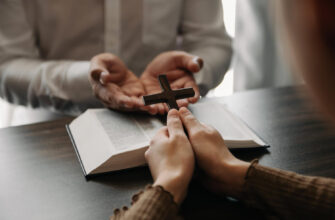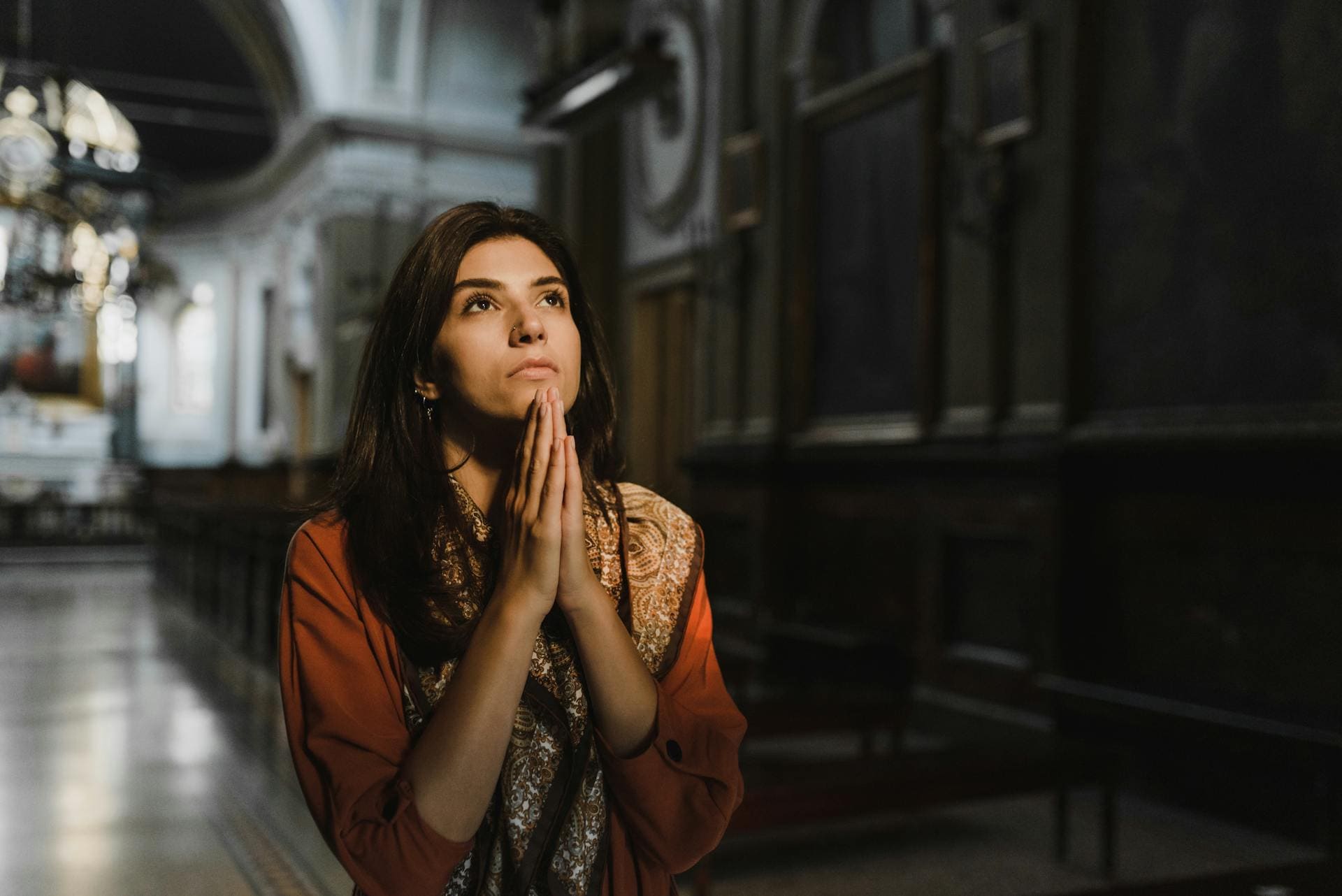Catholic symbols have been an important part of the Catholic Church for centuries. These symbols are used to represent the beliefs, traditions, and values of the Catholic faith.
They are often used in churches, on religious objects, and in art. The symbols are rich in meaning and can be interpreted in different ways by different people.
Some of the most recognizable Catholic symbols include the cross, the crucifix, the dove, and the lamb. Each symbol has its own unique meaning and significance.
For example, the cross is a symbol of sacrifice, hope, and salvation, while the dove represents peace and the Holy Spirit.
The lamb is often used to represent Jesus as the sacrificial lamb who died for the sins of humanity.
If you are interested in learning more about Catholic symbols and their meanings, this article will provide you with a full list and guide.
We will explore the most common Catholic symbols, their origins, and their significance.
Whether you are a devout Catholic or simply curious about the faith, this guide will help you gain a deeper understanding of the rich symbolism that is an integral part of the Catholic Church.
Cross and Crucifix
The cross and crucifix are two of the most recognizable symbols in Catholicism. The cross is a symbol of Christianity, representing the crucifixion of Jesus Christ.
The crucifix is a cross with the figure of the body of Jesus Christ attached to it. This is a very common Catholic symbol that is often placed on or above the altar where the Eucharist is celebrated.
There are different interpretations of the meaning of the cross and crucifix in Catholicism. Some see it as a symbol of suffering and sacrifice, while others see it as a symbol of hope and redemption.
The Catholic Church uses both the cross and the crucifix in its religious practices and ceremonies.
There are clear allusions to the cross and crucifixion of Jesus Christ in the Old Testament.
For example, the Greek letter T (tau or thau) appears in Ezechiel (ix, 4) as a solemn symbol of the Cross of Christ. This symbol is also used in the Catholic Church during the season of Lent, as a reminder of the sacrifice of Jesus Christ.
It is important to note that while both the cross and crucifix are used in Catholicism, they have different meanings.
The cross represents the sacrifice of Jesus Christ, while the crucifix represents his suffering and sacrifice.
The crucifix is often used in Catholic devotions such as the Stations of the Cross, as a reminder of the passion of Christ.
Chi Rho
The Chi Rho is an ancient Christian symbol that represents Jesus Christ and Christianity. It is formed by overlaying the first two letters of the Greek word “Christos” (ΧΡΙΣΤΟΣ) in such a way that the vertical stroke of the letter “Rho” intersects the center of the letter “Chi”.
The Chi Rho symbol was used by early Christians, and it is attributed to the Roman Emperor Constantine I.
The first public use of the Chi Rho symbol was on the labarum, the shield of Constantine’s warriors in the Battle of Milvian Bridge in 312 AD.
The Chi Rho symbol is still used today by many Christian denominations, including the Catholic Church. It is often seen on vestments, banners, and other religious items.
The symbol is also used in art and architecture, such as in stained glass windows, mosaics, and sculptures.
Overall, the Chi Rho is a powerful symbol of the Christian faith that has been used for centuries. Its simple design and deep meaning make it a popular choice for those looking to express their faith through art and symbolism.
IHS
The IHS symbol is a Christogram that represents the name of Jesus Christ. It is derived from the first three letters of the Greek spelling of the name ΙΗΣΟΥΣ (Jesus).
The letters are often stylized and combined to form a monogram that represents the name of Jesus.
The IHS symbol has been used in Christian art and architecture for centuries. It is often found on altars, crucifixes, and other religious objects.
The symbol has been used by many different Christian denominations, including the Roman Catholic Church, the Eastern Orthodox Church, and the Anglican Church.
The IHS symbol is often associated with the Eucharist, which is the central sacrament of the Catholic Church.
The letters are sometimes interpreted as standing for “Iesus Hominum Salvator” (Jesus, Savior of Mankind) or “In Hoc Signo” (In this Sign), which is a reference to the vision that the Roman Emperor Constantine had before the Battle of Milvian Bridge.
Overall, the IHS symbol is a powerful representation of the name of Jesus Christ and his role as the savior of mankind.
It is a symbol that is rich in history and meaning, and it continues to be an important part of Christian art and architecture today.
The Fish (Ichthus)
The fish, or ichthus, is a symbol that has been used by Christians since the early days of the Church. It is made up of two intersecting arcs that resemble the profile of a fish, with the ends of the right side extending beyond the meeting point.
The Greek word for fish is “Ichthus,” which is also an acronym for Jesus Christ, Son of God, Savior. The symbol is often used to represent the Christian faith as a whole.
The fish symbol has a long history in Christianity. It is believed to have been used by early Christians as a secret symbol to identify themselves to one another.
The symbol was also used to mark meeting places and gravesites of early Christians. Today, the fish symbol is still used by Christians around the world to represent their faith.
The fish symbol is not only used in Christianity but also in other religions and cultures. For example, the fish was a symbol of the goddess Atargatis in ancient Syria.
In Hinduism, the fish is associated with the god Vishnu. In Buddhism, the fish symbolizes happiness and freedom.
Overall, the fish symbol is a powerful and meaningful symbol that has been used by Christians for centuries.
It represents the faith, hope, and love that Christians have in Jesus Christ, and it continues to be a symbol of unity and fellowship among believers today.
The Dove
The dove is a universal symbol of the Holy Spirit in Catholicism. It represents purity, peace, and love. At Christ’s baptism, the Spirit’s presence was noted by a dove descending upon Christ (Matthew 3:16; Mark 1:10, with similar passages in John and Luke).
The dove is also a symbol of the entry into glory of the martyrs and saints (cf. Psalm 123:7: “Our soul is escaped as a bird from the snare of the hunters, the snare is broken and we are delivered.”)
As an artistic symbol, the dove appears frequently in ancient ecclesiastical art. It is often depicted in representations of the baptism of Our Lord (Matthew 3:16) and of Pentecost. St. Gregory the Great (590-604) is generally shown with a dove whispering in his ear, symbolizing the Holy Spirit inspiring him.
In addition to being a symbol of the Holy Spirit, the dove also has other meanings in Catholicism. Two doves on a funeral monument sometimes signify the conjugal love and affection of the parties buried there. The caged dove signifies the human soul yet imprisoned in the flesh and held captive.
Overall, the dove is a powerful symbol in Catholicism, representing the Holy Spirit and other important concepts such as purity, peace, and love.
The Lamb
The lamb is a significant symbol in Catholicism, representing several important concepts. Firstly, the lamb represents the perfection of God’s creation.
In the book of John, Jesus is referred to as the “Lamb of God” (John 1:29). This phrase is often used in reference to the sacrifice that Jesus made for humanity’s sins, as the lamb was a common sacrificial animal in ancient times.
The lamb also symbolizes innocence and purity, as it is often depicted as a gentle, meek creature. This is reflected in the popular hymn, “Jesus, Meek and Humble of Heart,” which compares Jesus to a lamb.
Additionally, the lamb is often used as a symbol of peace and tranquility, as it is a gentle animal that does not harm others.
Another important use of the lamb symbol is in reference to the Good Shepherd. In John 10:11, Jesus says, “I am the good shepherd. The good shepherd lays down his life for the sheep.”
In this context, the lamb represents the faithful followers of Jesus, who are protected and cared for by the Good Shepherd.
Finally, the lamb is often used in Catholic art and iconography. One example is the Agnus Dei, a traditional image of a lamb holding a banner with a cross. This image is often used in liturgical settings, such as during the Eucharist.
The Keys of St. Peter
St. Peter is one of the most prominent figures in the Catholic Church, and he is often depicted holding keys. These keys are known as the Keys of St. Peter, and they have a special significance in Catholicism.
According to Catholic teaching, Jesus promised the keys to heaven to St. Peter, empowering him to take binding actions. In the Gospel of Matthew 16:19, Jesus says to Peter, “I will give you the keys of the kingdom of heaven, and whatever you bind on Earth shall be bound in heaven, and whatever you loose on Earth shall be loosed in heaven.”
The Keys of St. Peter are often depicted as two crossed keys, one gold and one silver. The gold key represents the power to bind and loose in heaven, while the silver key represents the power to bind and loose on earth.
Together, the keys represent the power and authority of the Pope, who is considered to be the successor of St. Peter.
The Keys of St. Peter are also a symbol of the Catholic Church as a whole. They represent the power of the Church to forgive sins and grant access to heaven.
They are a reminder that the Church has the authority to guide and direct its followers, just as St. Peter was given the keys to guide and direct the early Christian community.
The Crown of Thorns
The Crown of Thorns is a powerful symbol of the Passion of Christ. It is believed to be the crown that was placed on Jesus’ head before his crucifixion. The crown was made of thorn branches, which were twisted together to form a circle.
The soldiers who mocked Jesus placed the crown on his head, causing the thorns to pierce his scalp and draw blood.
The Crown of Thorns is a reminder of the suffering that Jesus endured for the sake of humanity. It is often depicted in artwork and is used as a symbol in Catholicism.
The crown is also a relic that is said to have been preserved by the Church. There are several purported remnants of the Crown of Thorns, including one that is kept at Notre-Dame Cathedral in Paris.
Many Catholics believe that the Crown of Thorns represents the sacrifice that Jesus made for the salvation of humanity. It is a symbol of the love that Jesus had for humanity, even in the face of great suffering.
The crown is also a reminder of the importance of humility, as Jesus accepted the crown of thorns in meekness and humility.
The Sacred Heart
The Sacred Heart is one of the most recognizable symbols in Catholicism. It represents the divine love of Jesus Christ for humanity. The symbol depicts the heart of Jesus Christ with a crown of thorns and flames surrounding it.
The flames represent the burning love of Christ for humanity, while the crown of thorns represents the suffering He endured during His crucifixion.
The devotion to the Sacred Heart is widespread in the Catholic Church, with many churches and religious orders dedicated to it. It is believed that the devotion originated in the Middle Ages and was popularized by St. Margaret Mary Alacoque in the 17th century.
The Sacred Heart is often associated with the concept of divine mercy. It is believed that by meditating on the Sacred Heart, one can receive the mercy and love of Christ. The devotion to the Sacred Heart is also associated with the idea of reparation, or making amends for sins.
By offering prayers and sacrifices to the Sacred Heart, one can make reparation for their sins and those of others.
Overall, the Sacred Heart is a powerful symbol of the love and mercy of Jesus Christ. It is a reminder of the sacrifice He made for humanity and the boundless love He has for us.
The devotion to the Sacred Heart continues to be an important part of Catholic spirituality today.
The Rosary
The Rosary is a Catholic prayer tool that dates back to the 12th century. It is a set of beads that is used to keep track of prayers and meditations.
The Rosary consists of five sets of ten beads, called decades, with a larger bead separating each decade.
The beads are used to count prayers, with each decade representing a different mystery from the life of Jesus Christ.
The Rosary is a powerful tool for meditation and prayer. It is often used for personal devotion or as part of a larger prayer service. The prayers of the Rosary include the Apostle’s Creed, the Our Father, the Hail Mary, and the Glory Be.
Each decade is focused on a particular mystery, such as the Joyful Mysteries, the Sorrowful Mysteries, or the Glorious Mysteries.
The Rosary is a symbol of Catholic devotion and faith. It is often carried as a personal item or given as a gift to mark special occasions.
The Rosary is also a symbol of unity, as Catholics around the world use this prayer tool to connect with each other and with God.
Here is a table that lists the prayers of the Rosary:
| Prayer | Number of Times |
|---|---|
| Apostle’s Creed | 1 |
| Our Father | 1 |
| Hail Mary | 10 |
| Glory Be | 1 |
The Rosary is a powerful symbol of Catholic faith and devotion. It is a tool for prayer and meditation that has been used for centuries.
Whether used for personal devotion or as part of a larger prayer service, the Rosary is a powerful way to connect with God and with other Catholics around the world.
Conclusion
Catholic symbols are an integral part of the Catholic faith, representing its beliefs, values, and traditions. They are used in various forms of Catholic art, including paintings, sculptures, and stained glass windows, and are also present in Catholic liturgy and sacraments.
From the crucifix, which represents the ultimate sacrifice of Jesus Christ for the redemption of humanity, to the dove, which symbolizes the Holy Spirit, Catholic symbols are rich in meaning and significance.
Other symbols, such as the fish and the fleur-de-lis, have historical and cultural significance as well.
Understanding Catholic symbols can deepen one’s appreciation and understanding of the Catholic faith, and can also serve as a source of inspiration and reflection.
Whether one is a lifelong Catholic or simply curious about the faith, learning about Catholic symbols can be a rewarding experience.
FAQ
Catholic symbols are objects or images used in Catholic art, architecture, and liturgy to represent spiritual and religious concepts.
Some common Catholic symbols include the cross, the Sacred Heart, the Rosary, the Alpha and Omega symbols, and the Chi-Rho symbol.
Catholic symbols can have deep meanings and are often used to convey complex theological concepts in a visual way. They aid in worship and help Catholics understand the teachings and beliefs of the Church.
While some symbols may be shared across different Christian denominations, the specific meanings and usage of symbols can differ between them. Catholics have their own unique set of symbols that are significant to their faith and practice.
Catholic symbols help Catholics to visually connect with their faith and its teachings. They can provide a tangible reminder of the faith and serve as a focal point during prayer and worship. Additionally, Catholic symbols are often used in religious education to help people better understand the teachings and beliefs of the Church.
Catholic symbols can evolve and change over time, depending on cultural and historical factors. However, the core meanings of these symbols remain the same, and they continue to be important elements of Catholic worship and practice.
Most Catholic symbols have religious or spiritual meanings, but there are also some cultural symbols that are associated with Catholicism. These symbols may have cultural significance, but are not necessarily religious in nature.
While anyone can use Catholic symbols, it is important to understand and respect their meaning and significance within the context of Catholicism. Catholics may have specific guidelines for how these symbols should be used within their faith and worship practices.
Catholic symbols can be used in non-Catholic contexts, but it is important to be aware of their meanings and significance within the Catholic faith. Using these symbols without proper context or understanding can be disrespectful to Catholics and their beliefs.
Catholic symbols are often used in Catholic education to help students better understand the teachings and beliefs of the Church. They can serve as visual aids and help to engage students in the learning process.
Catholic symbols are often used in Catholic liturgy to help convey the teachings and beliefs of the Church. They can be incorporated into the design of the church, used in religious processions, and displayed during worship services.
Many Catholic symbols have a long history and are deeply rooted in the Church’s tradition and heritage. They have evolved over time and have been influenced by cultural and historical factors.
Catholic symbols can be interpreted in a variety of ways, depending on the context in which they are used and the individual’s personal beliefs and experiences. They can be seen as representations of spiritual and religious concepts, as well as cultural and historical meanings.
There may be regional or cultural differences in the use of Catholic symbols, depending on the specific traditions and practices of different Catholic communities. For example, some symbols may be more prevalent in certain regions or countries than in others.
Catholic symbols can be used in personal devotions, such as prayer and meditation, as a way to connect with the divine and deepen one’s spiritual life. However, it is important to approach these symbols with respect and understanding of their meaning within the Catholic faith.
Catholic symbols are a common subject in Catholic art and are often used to convey the teachings and beliefs of the Church. They can be found in various forms of art, including painting, sculpture, and stained glass.
Catholic symbols can have multiple meanings, depending on the context in which they are used and the individual’s personal interpretation. The meanings of symbols can also evolve over time and may have different significance in different cultural or historical contexts.
Catholic symbols can be used in evangelization to communicate the teachings and beliefs of the Church to those who may not be familiar with them. They can serve as visual aids that can help to engage and educate others about Catholicism.
Catholic symbols are often used in Catholic sacraments, such as baptism, confirmation, and Eucharist. They can help to signify the spiritual significance of these sacraments and can aid in the worship and celebration of these sacred rituals.
Catholic symbols can be used in interfaith contexts, but it is important to be aware of their meaning and significance within the Catholic faith. They should be used with respect and sensitivity to the beliefs and practices of other religious traditions.
While physical objects and images are the most common forms of Catholic symbols, Catholicism also recognizes symbolic actions and gestures. For example, the sign of the cross is a symbolic action that represents the sacrifice of Jesus Christ.
Catholic symbols can be used for personal expression, such as in personal art, jewelry, or clothing. However, it is important to approach these symbols with respect and understanding of their meaning within the Catholic faith.
Catholic symbols are often used in Catholic devotions, such as the Rosary or the Stations of the Cross. They can help to focus the mind and heart on specific aspects of Catholic faith and practice.
While Catholic symbols are specifically associated with Catholicism, they may be used in non-Catholic religious contexts as a way to represent shared spiritual and religious concepts. However, it is important to be aware of their specific meaning within the context of Catholicism.
Catholic symbols are an important aspect of Catholic theology, as they help to represent and convey complex theological concepts in a visual and tangible way. They are often used to help Catholics deepen their understanding and appreciation of their faith.







